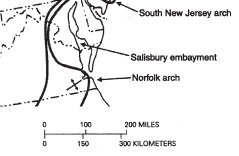 The sediments found in
and around Calvert County
were deposited during
the Miocene Epoch in geologic time, in a shallow bay named the
Salisbury Embayment. This feature existed on the Atlantic Coastal
plain,
an area that today would encompass all of Maryland, northern Virginia,
and most of New Jersey. This plain was created more then 170
million
years ago as sea level rose following the breakup of the supercontinent of Pangea, and it collected
sediment over the next 160 million years. The Miocene sea was
home to a wide variety of marine life, including ostracods, clams,
oysters, corals, echinoids, foraminifera, brachiopods, gastropods,
fish, turtles, crocodiles, whales, and long-snouted dolphins. However,
this sediment also records a wide array of terrestrial animals such as
tapirs, mastodons, rhinoceros, peccaries, camels, elephants, horses,
dogs, and birds. As sea level fell, following the onset of the
current glacial period, these sediment packages, and the remains of the
organisms they contained, were slowly exposed at Earth's
surface, where weathering
and erosion have been excavating them for the past 12,000 years.
(Click photographs to enlarge)
The sediments found in
and around Calvert County
were deposited during
the Miocene Epoch in geologic time, in a shallow bay named the
Salisbury Embayment. This feature existed on the Atlantic Coastal
plain,
an area that today would encompass all of Maryland, northern Virginia,
and most of New Jersey. This plain was created more then 170
million
years ago as sea level rose following the breakup of the supercontinent of Pangea, and it collected
sediment over the next 160 million years. The Miocene sea was
home to a wide variety of marine life, including ostracods, clams,
oysters, corals, echinoids, foraminifera, brachiopods, gastropods,
fish, turtles, crocodiles, whales, and long-snouted dolphins. However,
this sediment also records a wide array of terrestrial animals such as
tapirs, mastodons, rhinoceros, peccaries, camels, elephants, horses,
dogs, and birds. As sea level fell, following the onset of the
current glacial period, these sediment packages, and the remains of the
organisms they contained, were slowly exposed at Earth's
surface, where weathering
and erosion have been excavating them for the past 12,000 years.
(Click photographs to enlarge)
